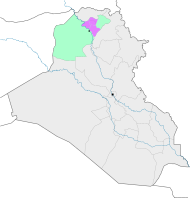| Revision as of 15:17, 2 May 2013 editElvis214 (talk | contribs)Extended confirmed users1,732 edits Undid revision 551599157 by 211.27.80.44 (talk)← Previous edit | Revision as of 08:19, 15 May 2013 edit undo58.179.169.152 (talk)No edit summaryNext edit → | ||
| Line 102: | Line 102: | ||
| |footnotes = | |footnotes = | ||
| }} | }} | ||
| '''Batnaya''' ({{lang-syr|ܒܛܢܝܐ}}) is an |
'''Batnaya''' ({{lang-syr|ܒܛܢܝܐ}}) is an Chaldean town in northern Iraq located 14 miles north of ] and around 3 miles north of ]. | ||
| == Etymology == | == Etymology == | ||
Revision as of 08:19, 15 May 2013
Place in Ninawa, Iraq| Batnaya ܒܛܢܝܐ | |
|---|---|
| Country | |
| Governorate | Ninawa |
| District | Tel Keppe |
| Population | |
| • Total | 5,000 - 10,000 |
| Time zone | GMT +3 |
Batnaya (Template:Lang-syr) is an Chaldean town in northern Iraq located 14 miles north of Mosul and around 3 miles north of Tel Keppe.
Etymology
The name Batnaya is of Aramaic origin derived from either "Beth Tnyay" meaning "The House of Mud" or "Beth Tnaya" meaning "The House of Assiduity".
History
Batnaya used to be called "Beth Madaye" meaning the "House of the Medes" where it's believed that a group of the Medes who followed the Median monk Oraham (Abraham) settled there around the seventh century. It's also believed that Christianity reached Batnaya around that time.
Batnaya was attacked by the army of Nader Shah in 1743 who destroyed the village extensively and is believed to have killed half of its inhabitants.
In the past Batnaya used to be famous for making matting from the reeds its people used to cultivate in the valley of al-Khoser river. Currently, some of its inhabitants are cultivating different kinds of crops while others are involved in non-agricultural trades.
In 1944 the Mar Qeryaqos Church was built on the ruins of a monastery by the same name believed to have been built early 15th century. A second but smaller church Mart Maryam was built in 1966, while the church of Mar Gewargis was mentioned in an inscription dating 1745.
In Batnaya are several inscriptions, one dating to 1545 by Darweesh bin Yohanan from the village of Aqreen is entitled "Prayers for the Dead", another one is a complete bible inscribed in Syriac by the priest Ataya bin Faraj bin Marqos of Alqosh dating 1586.
As all the other currently Assyrian villages who belong to the Chaldean Catholic Church, Batnaya used to follow the Church of the East, till the sixteenth century when finally the efforts of the Catholic Church gained fruit and the Eastern Church was divided. However, again as is the case with all the other villages of the Nineveh Plains, Catholicism did not gain ground till around mid 18th century.
Population
During the 17th and 19th century the town had about 900 people, in 1995 the town grew to about 3000 people. Today it exceeds over 6000 people and is rising. All the people in the town are Assyrian belonging to the Chaldean Catholic Church.
Modern day Batnaya
In 2007, because of the growth of the town, Sargis Aghajan built 25 new model houses near the Monastery of Mar Oraha which is beside the town. The Provision of municipal services to the village and monastery through the supply of two tractors for harvest & Agriculture, and a dumper to collect garbage as well as employment of labourers to clean the access roads in the village.
References
- Originally based on an article by betnahrain.net , licensed under the GNU Free Documentation License, used with permission.
- http://www.ishtartv.com/en/viewarticle,35878.html
| Nineveh Plains in Nineveh Governorate, northern Iraq | |||||||||||
|---|---|---|---|---|---|---|---|---|---|---|---|
| Main settlements |
|  | |||||||||
| Religious sites |
| ||||||||||
| Archaeological sites | |||||||||||
| See also | |||||||||||